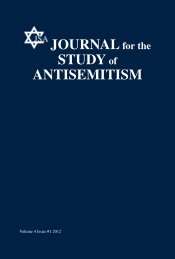Journal for the Study of Antisemitism
Journal for the Study of Antisemitism
Journal for the Study of Antisemitism
You also want an ePaper? Increase the reach of your titles
YUMPU automatically turns print PDFs into web optimized ePapers that Google loves.
220 JOURNAL FOR THE STUDY OF ANTISEMITISM [ VOL. 1:209<br />
There are always <strong>the</strong>se. . .images one has <strong>of</strong> Jews: that he . . . . has a long<br />
nose, that he has always a lot <strong>of</strong> money and that he’s stingy. That’s what<br />
is meant by it in <strong>the</strong> end. You could circumscribe it but you just say<br />
“Jew” <strong>for</strong> it.<br />
(Sharif, Berlin, P16: 159)<br />
ESTABLISHING A NORM OF OPEN ANTISEMITISM THROUGH<br />
ANTISEMITIC LANGUAGE<br />
The trivialization <strong>of</strong> antisemitic language and <strong>the</strong> frequent usage <strong>of</strong><br />
such language leads to a norm <strong>of</strong> open antisemitism through consensual<br />
validation and repetition, particularly if no opposition is voiced. A norm <strong>of</strong><br />
antisemitic language is accompanied by antisemitic prejudices and <strong>the</strong><br />
establishment <strong>of</strong> a social order by labeling o<strong>the</strong>rs as “Jews.” The threat <strong>of</strong><br />
exclusion is a crucial part <strong>of</strong> establishing a social order. Nabil remembered<br />
that labeling someone as “Jew” had been used to exclude a student in his<br />
school, saying, “In our school, in our class, it was ra<strong>the</strong>r like <strong>for</strong> fun, like,<br />
‘Ugh, he is a Jew, don’t talk to him’” (Nabil, Berlin, P4: 55).<br />
The threat <strong>of</strong> exclusion through labelling someone as “Jew” can also<br />
be observed in some <strong>of</strong> <strong>the</strong> group interviews. In one group interview <strong>the</strong><br />
conversations turned to Jewish pupils in schools. Nazim stated that <strong>the</strong>re are<br />
no Jews in his school. This was used by ano<strong>the</strong>r participant to label Nazim<br />
himself as “Jew,” which he denied. He was acknowledged and <strong>the</strong> interview<br />
continued only after he assured <strong>the</strong> group that he has <strong>the</strong> same ethnic identity<br />
as <strong>the</strong> o<strong>the</strong>r group members: 18<br />
Nazim: In our school <strong>the</strong>re aren’t any.<br />
Amir: You, you’re a Jew [Juif]!<br />
Nazim: No, I’m not a Jew [Juif].<br />
Amir: What are you <strong>the</strong>n?<br />
Nazim: I am an Arab!<br />
Amir: Ah ok.<br />
(Nazim and Amir, Paris, P50: 237-256)<br />
Some interviewees exclude religious or ethnic minorities from <strong>the</strong>ir<br />
collective community and label <strong>the</strong>se minorities “Jews.” One interviewee,<br />
<strong>for</strong> example, declared that Alevis are not Muslims, whereupon his friend<br />
exclaimed that <strong>the</strong>y are “Jews.” Ano<strong>the</strong>r one told us that he has been<br />
labeled “Jew” by Turks because <strong>of</strong> his Kurdish identity.<br />
18. Most interviewees expressed <strong>the</strong> belief that an Arab and a Jewish identity<br />
are exclusive even though, paradoxically, many interviewees know about <strong>the</strong> fact<br />
that <strong>the</strong>re are Arab Jews.














